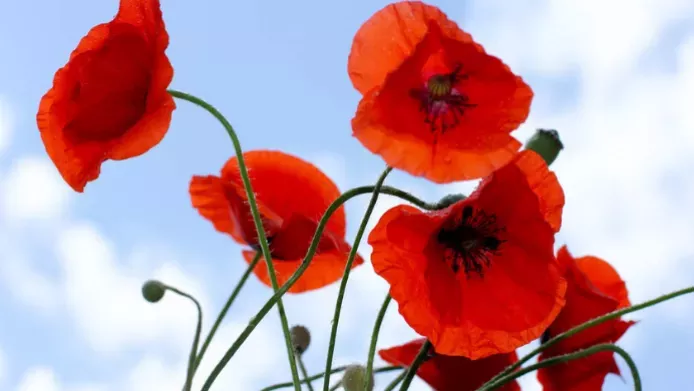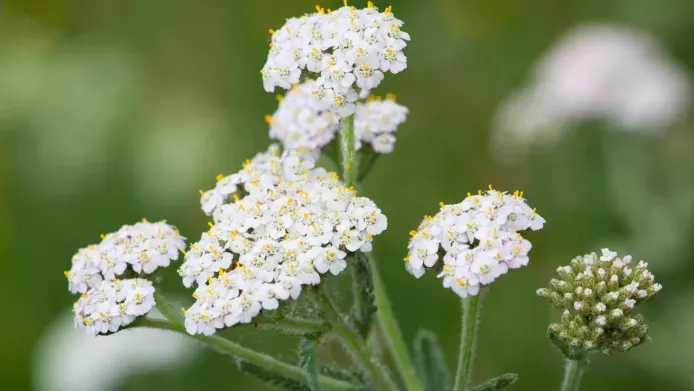Beautiful, diverse, colourful and unique, flowers have been tools of LGBTQ+ symbolism for centuries. This Pride Month we take a look at some of the flowers closely associated with queer communities.
What does LGBTQ+ mean?
LGBTQ+ is defined by Stonewall as the acronym for lesbian, gay, bi, trans, queer, questioning and ace.
What is Pride Month?
Pride month takes place in June to commemorate the June 1969 Stonewall Uprising, New York riots, which momentously progressed the LGBT+ civil rights movement.
Celebrations and events are held to mark how far LGBTQ+ rights have come, showcase the work of LGBTQ+ people, and educate about issues impacting the LGBTQ+ community.
 Multicoloured roses are popular at Pride events
Multicoloured roses are popular at Pride events
What is floriography and what is the connection to LGBTQ+ people?
Floriography – the language of flowers – refers to the use of flowers to communicate and represent specific meanings and feelings.
Poppies are a common symbol of remembrance, daffodils of rebirth and the four-leaf clover of good luck.
There have and continue to be many places where LGBTQ+ people are unable to safely communicate parts of their gender and sexuality. The ability to portray unspoken messages to people in the know is one of the reasons flowers have become important in queer symbolism.
Flowers associated with queer symbolism
Violets
The earliest association between floriography and LGBTQ+ people is associated with Sappho, the Ancient Greek poet from the island of Lesbos (from where the word lesbian derives). Known for her romantic and homoerotic poetry, Sappho’s depictions of women and girls had numerous references to violets, which led to violets becoming symbolic gifts amongst lesbians.
Tennessee Williams references the symbolism of violets through the character Mrs. Violet Venable in his play Suddenly Last Summer (1958), in which a poet who is secretly gay is murdered.
 Sweet Violets (Viola odorata)
Sweet Violets (Viola odorata)
There are two native species of violet in the UK, Common Dog Violet (Viola riviniana) and Sweet Violet (Viola odorata). Both can be found in woodlands and flower in spring.
Lavender
Purple is an important colour in queer symbolism, particularly lavender.
Use of the word lavender to refer to homosexuality became common in the early 20th century, after the biographer of Abraham Lincoln wrote that one of the President’s male friendships had a ‘streak of lavender’. Although this insult gained popularity in the 1920’s, it’s since been reclaimed by LGBTQ+ communities and ‘lavender’ is often used interchangeably with ‘rainbow’ to reference ‘LGBTQ+’.
 Common Sea Lavender (Limonium vulgare)
Common Sea Lavender (Limonium vulgare)
Commonly, 'lavender' refers to European species of the Lavandula genus, such as French Lavender (Lavandula stoechas), native to the Mediterranean, or English Lavender (Lavandula angustifolia), which, despite its name, is not a UK native.
Native to the UK is a plant known as Common Sea Lavender (Limonium vulgare). Unrelated to Lavandula species, this wildlife-friendly coastal plant doesn’t have the scent of lavender but has the same recognisable colour.
Carnations
At the premiere of his 1892 play, Lady Windermere’s Fan, Oscar Wilde famously introduced the green carnation as a queer symbol by instructing some of his friends to wear them on their lapels. Wearing a green carnation became a secret way to communicate you were a gay man, at a time when homosexuality was still illegal.
To this day carnations are worn or displayed as a symbol of queer pride – trans Hollywood star Elliot Page notably paid tribute to Wilde by wearing a green flower pinned to his suit for the Met Gala in 2021.

Since being introduced to the UK around the sixteenth century, carnations (Dianthus caryophyllus) have become naturalised in the wild, though they have not been here long enough to be considered ‘native’. Also known as Clove Pinks, they are widely cultivated for the commercial flower industry.
Pansies
The term ‘pansy’ is another that has a history of derogative use, initially in referring to queer men.
During the 1930’s queer representation, including drag queens, rose to prominence in popular culture and within the Hollywood film industry. This period became known as the ‘pansy craze’.
Since the 80’s the word has been positively reclaimed and is more commonly used as a lighthearted reference within queer circles. It has also inspired various anti-homophobic projects such as The Pansy Project, in which the artist Paul Harfleet plants pansies at sites of homophobic and transphobic abuse.
 Wild Pansy, also known as Heartsease (Viola tricolor)
Wild Pansy, also known as Heartsease (Viola tricolor)
Pansy is the common name used to refer to certain species of the Viola genus. Pansies native to the UK include the Wild Pansy (Viola tricolor) and the Mountain Pansy (Viola lutea).
Roses
Roses have symbolised love across cultures for centuries, each colour representing different forms of love, such as red for passion, yellow for friendship and dark pink for gratitude. Multicoloured roses are popular at pride events, reflecting love and referencing rainbows, another symbol amongst queer communities connected to colours on LGBTQ+ flags.
 Dog rose (Rosa canina)
Dog rose (Rosa canina)
Keep an eye out in the wild for roses native to the UK, such as Dog Rose (Rosa canina), Field Rose (Rosa arvensis) and Burnet Rose (Rosa spinosissima).
Keep an eye out for these symbolic flowers this Pride Month!
More about floriography

Related resources
Queer Botany: The Sapphic Violet (uw.edu)
Four Flowering Plants That Have Been Decidedly Queered - JSTOR Daily
At Last, An Entire Institute For Queer Ecology | Atmos
How lavender became a symbol of LGBTQ resistance | CNN
Queer Objects: Lace Sprig of a Pansy | Out and About (exeter.ac.uk)

